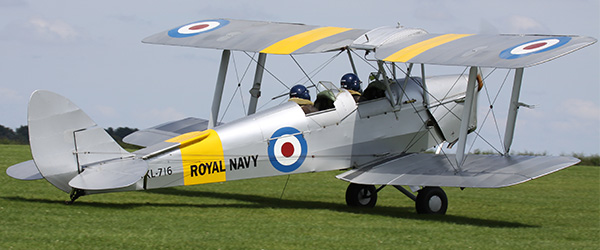Tiger Moth XL-716

Written by Gary Ritchie As featured on page 39 in the September 2012 issue of Model Aviation. As featured in the Model Aviation tablet app.
It’s no exaggeration to say that building Scale model aircraft is an art form. In fact, one could say that building any type of scale model is an art form. But with model aircraft there is that other dimension -flying it. At this point the art form morphs into a white-knuckle, heart pumping, high testosterone adventure.
I began my adventure a couple of years ago scouring through www.airliners.net looking for a photo of a pretty Tiger Moth to model. It didn’t take me long to find XL-716, a Royal Navy Tiger Moth stationed at the Compton Abbas Aerodrome in Dorset, England. She was a lovely silver airplane with bold yellow stripes and big, beautiful roundels on her wings and fuselage. It was love at first sight.
So I searched around until I found a set of 1/5 scale Tiger Moth plans ($30) on the Bob Holman Plans website. I called Bob to find out how true to scale the plans were, “Spot on” said Bob. “I’ll take ‘em” said I. When the large rolled plans arrived, I began examining them to learn that they had been rendered by a gentleman named Dennis Bryant way back in the 1970s and were designed for a glow engine, no surprise here. A note on the plan indicated that laser cut wood parts, vacuum-formed fairings and a fiberglass nose were available for sale from Traplet ($110). So I ordered a set. A very smart move on my part.
Tips for Flying
Here are a few tips I can pass on about flying a 1/5 scale Tiger Moth. First, be certain to feed in some right rudder on takeoff. If you don’t, the plane may veer sharply to the left.
Full-scale Tiger Moths’ have notoriously sloppy ailerons. So does my model. Because of this, I find that turns are smoother when initiated with the rudder. Whatever you do, don’t enter into a steep banking turn under low power. This is begging for a dangerous tip stall.
The Tiger Moth is surprisingly agile for a vintage biplane. It is capable of flying loops, hammerheads, spins, lazy-eights, wingovers, flat turns, Immelmans, side slips and other nifty maneuvers. However, it does not roll very well, nor does it like to fly inverted. But with a little coaxing the Moth can be a smooth, tight, and facile flying machine.
When landing, try to hold a touch of power through the entire landing process –this includes rollout. I found that if I cut the motor before the plane had finished rolling out, I was inviting a nose over, very embarrassing. Search YouTube for “XL-716, Royal Navy DeHavilland DH82A Tiger Moth” to enjoy a video of the full scale Tiger Moth XL-716 landing at Compton Abbas.
Read about the entire build and see photos of the process on page 39 in the September 2012 issue and on the tablet app.
Gary Ritchie
[email protected]










4 comments
go tiger!
Down load problems
Sony Tablet
FAB..........................
Add new comment